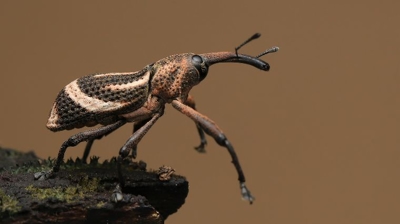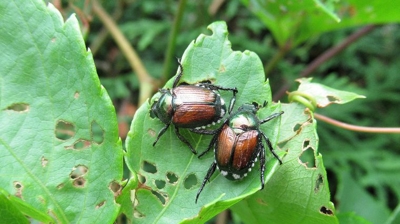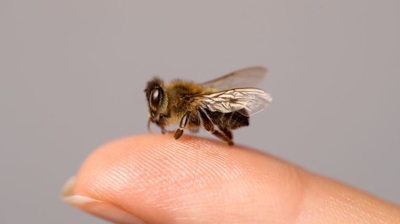
Cicadas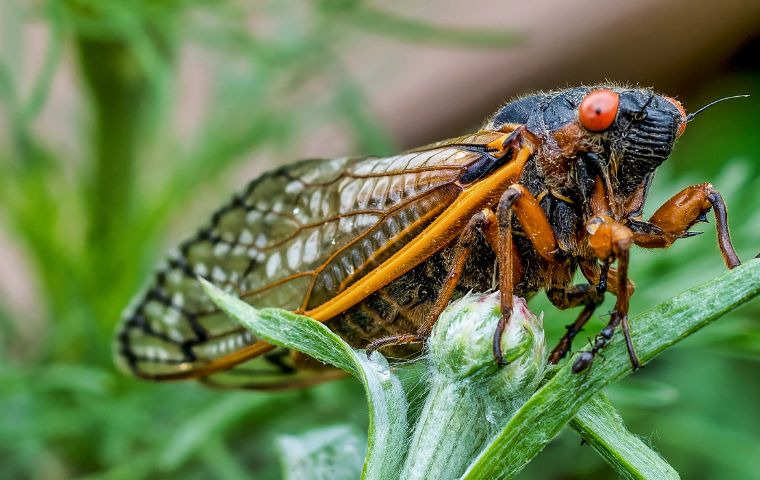
Cicada Identification
Cicadas are insects known for their distinctive appearance. These large, flying insects are best recognized for their robust bodies, transparent wings, and loud buzzing calls. Here's what cicadas look like:
- Size: Cicadas vary in size depending on the species, but they typically measure between 1 to 2 inches (2.5 to 5 cm) in length. Some larger species can reach up to 3 inches (7.5 cm).
- Body: The body of a cicada is stout and elongated, with a somewhat triangular shape. They have a tough exoskeleton that is usually black, brown, or green, which helps protect them from predators.
- Head: Their large, prominent compound eyes are one of their most striking features. These eyes provide them with excellent vision. Cicadas also have three simple eyes, or ocelli, on top of their head.
- Antennae: Cicadas have short, bristle-like antennae that are positioned between their eyes.
- Wings: Cicadas have two pairs of wings. The front wings are longer and more prominent, while the hind wings are membranous. The wings are often transparent and veined, with intricate patterns. In some species, the wings are colored, ranging from green to brown.
- Legs: Cicadas have six legs, which are adapted for clinging to trees or other surfaces. Their legs may have spines or hooks that help them grip onto branches.
- Abdomen: The abdomen of a cicada is segmented and relatively wide, giving them their distinctive shape. Males typically have noisemaking structures on the sides of their abdomen.
- Mouthparts: Cicadas have piercing-sucking mouthparts that they use to feed on the sap of trees and plants. These mouthparts are adapted for extracting fluids from plant tissues.
Cicadas exhibit sexual dimorphism, meaning there are differences between males and females in terms of their appearance. Male cicadas often have noisemaking organs called tymbals on their abdomen, which they use to produce the loud, distinctive buzzing sound they are known for. Females lack these structures and tend to have a more pointed abdomen for laying eggs.
Cicadas are also known for their periodic emergence, with some species appearing in vast numbers after several years underground. These periodic cicadas are particularly noteworthy for their synchronized mass emergence events.
Cicadas are known for their robust bodies, prominent compound eyes, transparent wings with intricate veining, and distinctive calls produced by males. Their appearance can vary depending on the species, and they are fascinating insects with unique life cycles and behaviors.
Learn more: Can Cicadas Fly?
Cicada Habitats
Cicadas are widespread insects found in various parts of the world, but their distribution can vary depending on the species. Here's where you might find cicadas:
- North America: Cicadas are prevalent in many parts of North America. The United States, in particular, is home to a wide variety of cicada species. The periodical cicadas, which emerge in massive numbers at 13- or 17-year intervals, are famous in the eastern United States. You can find them in states like Ohio, Indiana, Illinois, and other eastern regions.
- South America: Cicadas are found throughout South America. They are often encountered in forests, grasslands, and other natural habitats. The Amazon Rainforest, for example, is home to numerous cicada species.
- Europe: Cicadas are less common in Europe compared to some other regions, but they can still be found in various European countries, especially in the southern and Mediterranean regions. Spain, Italy, and Greece have cicada populations.
- Asia: Asia has a rich diversity of cicada species. They can be found in a wide range of habitats, from forests to urban areas. Countries like Japan are known for their summer cicada choruses, and the cicadas in this region are culturally significant.
- Africa: Cicadas are distributed across Africa, with a presence in both tropical and subtropical regions. You can find them in wooded areas and savannas.
- Australia: Australia is home to a diverse range of cicada species. They are found in forests, woodlands, and urban areas across the country.
- New Zealand: Cicadas are present in New Zealand, primarily in the North Island and parts of the South Island. They are more abundant in warm, forested areas.
- Middle East: Cicadas can be found in parts of the Middle East, particularly in countries with diverse climates, such as Israel and Lebanon.
- Tropical and Subtropical Regions: Cicadas are often more abundant in tropical and subtropical regions due to the warm climate and the presence of suitable host plants for nymphs. They can be found in rainforests, grasslands, and deserts, depending on the species.
- Urban and Rural Areas: Cicadas can be found in both urban and rural environments. They are often attracted to light and may be more noticeable in urban areas during their adult stage.
The specific types of cicadas and their abundance can vary widely within each region. Some species have distinct emergence patterns, such as annual cicadas, while others have periodic cycles of 13 or 17 years. When and where you can find cicadas may depend on the particular species and their life cycle. During the summer months, you are more likely to hear the characteristic buzzing of cicadas in many of these regions.
Cicada Diet
Cicadas have distinct feeding habits that change throughout their life cycle, depending on their developmental stage. Here's what cicadas eat during each stage of their life:
Nymph Stage (Underground):
- Nymphs, which live underground, primarily feed on the xylem and phloem fluids of plant roots.
- They use their specialized piercing-sucking mouthparts to tap into plant tissues and extract nutrients.
- While nymphs primarily consume plant sap, they do not harm the overall health of mature trees or shrubs, as they tend to feed on small, herbaceous plants or grasses.
Adult Stage (Above Ground):
- Adult cicadas primarily feed on the xylem fluid of woody plants and trees.
- Their feeding is usually less damaging than that of nymphs, as they tend to target branches and twigs rather than the main trunks of trees.
- Cicadas have piercing-sucking mouthparts designed to penetrate plant tissues. They use their proboscis to access xylem fluid.
- The adult feeding is typically not considered harmful to mature trees, but in cases of high cicada populations, it can result in some damage to young or stressed trees.
While cicadas feed on plant fluids, they do not bite, sting, or consume other insects or animals. Their feeding behavior is generally considered more of an ecological interaction with plants rather than a direct threat to other organisms.
Cicadas play a role in nutrient cycling in ecosystems, as the excess fluids they consume are excreted in the form of "honeydew," which can benefit other organisms, including ants that may feed on it.
Additionally, the emergence of large numbers of adult cicadas can serve as a food source for various predators, including birds and small mammals, contributing to the ecological balance in their respective habitats.
Learn more: What Do Cicadas Eat?
Cicada Life Cycle
The life cycle of cicadas is a fascinating and unique process that involves several distinct stages, including both underground and above-ground phases. Here's the cicada life cycle:
- Egg Stage: The life cycle of cicadas begins when adult female cicadas use their ovipositors to lay eggs in the twigs and branches of trees, shrubs, or other woody plants. Cicada eggs are typically small and rice-grain-like in appearance.
- Nymph Stage: Once the eggs hatch, the young cicadas, known as nymphs, drop to the ground and burrow into the soil. Nymphs have strong, shovel-like front legs for digging and are adapted for a subterranean lifestyle. They feed on the sap from plant roots using their piercing-sucking mouthparts. Depending on the species, the nymph stage can last for several years, with some cicadas having exceptionally long life cycles (e.g., 13 or 17 years).
- Molting Stage: As they grow, nymphs go through several instars (developmental stages) during which they shed their exoskeletons in a process called molting. The number of molts can vary depending on the species, but it typically ranges from four to five times.
- Emergence Stage: After the final molt, nymphs dig their way to the surface to emerge as winged adults. They leave behind the exoskeletons, known as exuviae, which can often be found attached to trees or other surfaces. Cicadas emerge in large numbers, sometimes known as "broods," which can number in the thousands or even millions. Once on the surface, the winged adults are highly active and engage in mating and reproduction.
- Adult Stage: Adult cicadas have distinctive features, including large compound eyes, transparent wings, and often, vibrant colors. Male cicadas produce loud buzzing or chirping sounds to attract females. These sounds are generated by vibrating structures called tymbals on their abdomen. Females lay eggs, completing the life cycle, and then adults typically live for only a few weeks.
- Death and Decomposition: After mating and egg-laying, adult cicadas die. Their bodies decompose, returning nutrients to the ecosystem.
Cicadas are known for their periodic emergences, with different species having distinct life cycle durations, such as 13 or 17 years. This long life cycle is thought to be an adaptation to avoid predation by predators with shorter life cycles. The synchronized mass emergences of periodical cicadas are a remarkable phenomenon in the natural world.
Understanding the cicada life cycle is crucial for studying and predicting their emergence patterns, especially in regions where periodic cicadas are prevalent. These insects play an essential role in various ecosystems and are of ecological and scientific interest.
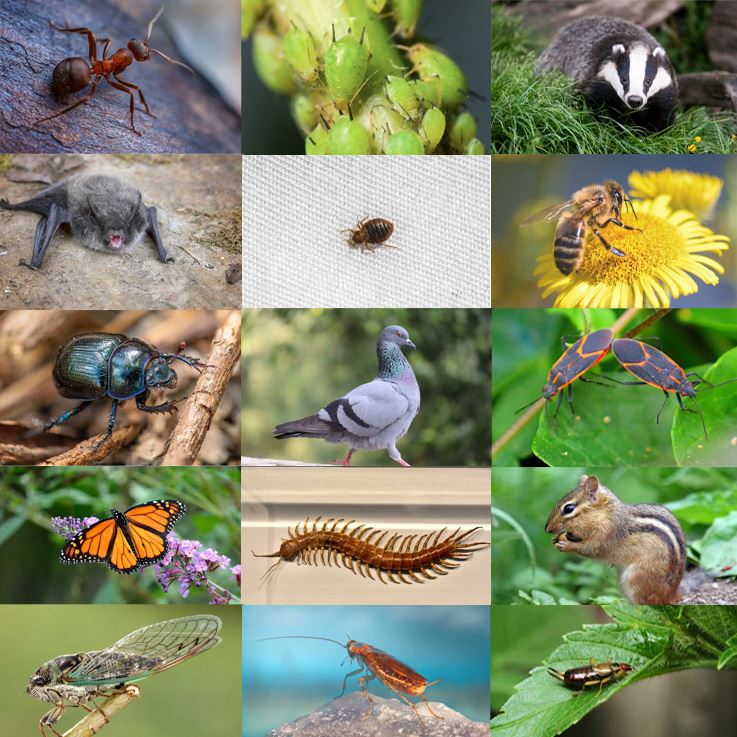

Hear From Our Happy Customers
-
"Great Communication"
Tech was on time, communication was great, and he accommodated my needs.
- Alonzo W. -
"Wonderful Service"
Wonderful service. Jarvis is great. Took care of everything I needed. Thank you!
- Henry P. -
"Very Knowledgeable"
The tech that arrived was courteous, professional, and very knowledgeable. He was Great.
- Uerial I. -
"Fantastic & Patient"
Jarvis was fantastic and patient. He answered my questions with an in-depth explanation and addressed all of my areas of concern. Would love for him to be my assigned tech going forward. Well done!
- Yonnette M. -
"Professional & Considerate"
I’m pleased with Miche services. Jarvis came today. Professional and considerate. Thank you!
- Judy B. -
"Exceeds Expectations"
I can’t say enough positive things about this company... The tech that came out, Jarvis went above and beyond my expectations. Thank you guys, I will continue using your services.
- Jake M.

